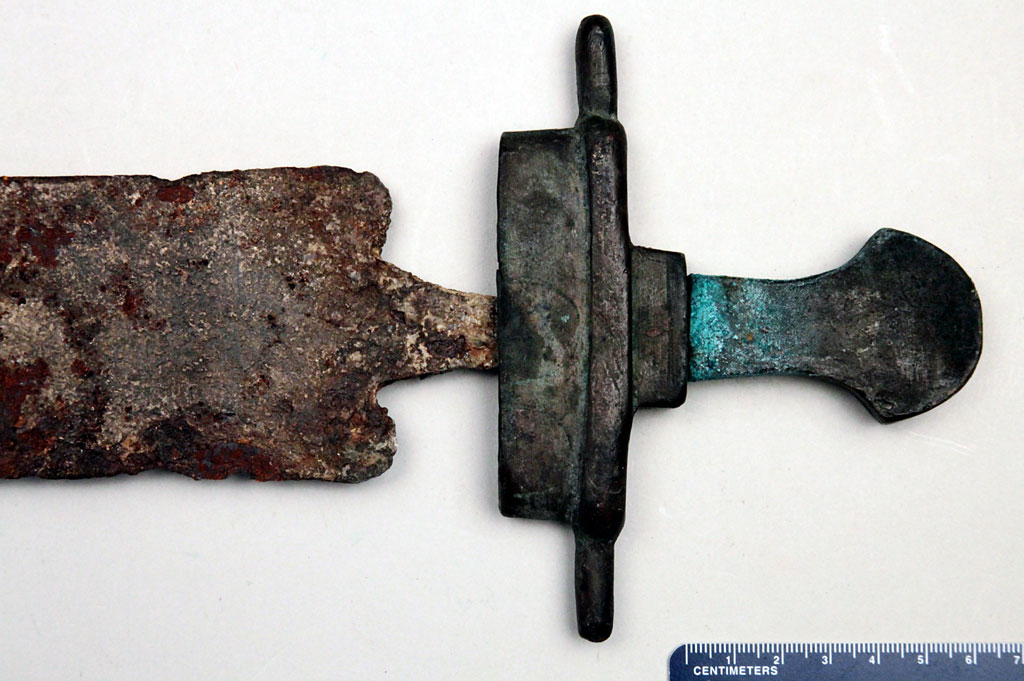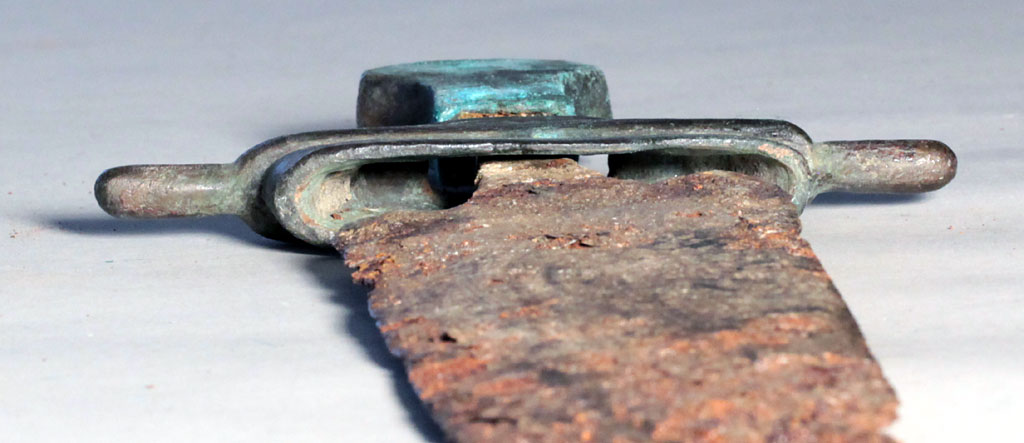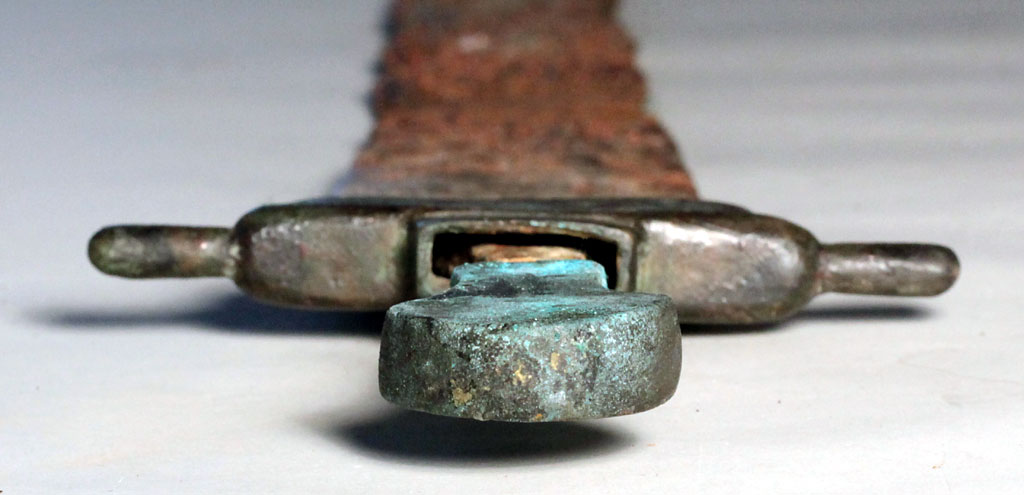
A Likely Byzantine or Fatimid Sword of the Xth – XIth Centuries
October 9, 2023 European Arms
Introduction
This extremely rare sword from the collection of Dr. Lee Jones represents a rarely encountered subtype of swords which are thought to be either Fatimid or Byzantine and heavily influenced by Arab designs. Extant examples are few and the piece presented here is unique in several respects.
Unfortunately, no provenance is available for a geographical region where this piece was recovered, however several similar examples are known with near identical construction and physical attributes across a range previously controlled or influenced by the Byzantine Empire as well as the Arab armies of the Fatimids and Abbasids. Dawson, Aleksic, Yotov, Baranov and Rabovyanov have written extensively on the matter of early Byzantine swords and their connections to Arab and Persian examples, however it is still difficult to positively attribute some swords to Byzantine or Arab manufacture given the extensive interactions between these groups.
This short work will examine the physical characteristics of this piece and contrast the key elements of the guard and pommel with extant examples, chiefly a set of finds from Bulgaria.
Physical Characteristics
The sword features a broad blade without fullers or other visible geometry. The profile tapers towards the tip with a pronounced and sharp point. The condition of the blade is excavated with losses to the edges and overall corrosion. The base of the blade features rounded shoulders with a tang extending through the hilt furniture and pommel.
The sword weighs 1069 grams in its present state; overall length is 83.4 cm with the blade being 71.2 cm. Near the base (70 cm from tip) the blade is 6.4 cm wide and 0.51 cm thick; at 40 cm from the tip the blade is 5.1 cm wide and 0.54 cm thick and at 10 cm from the tip the measurements are 3.8 cm wide and 0.57 cm thick. The thickness in the 'best preserved' section is 0.55 cm. In this section near the forte the blade cross section is that of a flattened hexagon with the central facet being 2.7 cm wide.
The guard is 3.76 cm long, 12.9 cm wide and 1.59 cm thick. The pommel is 3.99 cm wide, 6.06 cm long and 1.39 cm thick.

(images: Dr. Lee Jones)
The hilt consists of a cast bronze crosspiece with a ‘cuff’ extending over the blade, short, integral quillons and a small extension into the grip. The pommel is similarly cast, extending to form part of the grip with a fairly flat profile and curved top. The remainder of the grip would have been formed of a wood core likely covered with leather.


(images: Dr. Lee Jones)
The pommel seems to be to be hollow to accommodate the tang and also appears to be cast as a single piece as does the guard.


(images: Dr. Lee Jones)
The pommel is a particularly unusual form. As will be seen below, swords of this type usually have a “cap” like pommel whereas this example is, as far as the author is aware, unique in its form, vaguely resembling a ‘scent stopper’ type with a rounded top and square base. The pommel is not peened. The shoulders and the tang are visible showing valuable detail regarding the forging of the blade.

The cuff is separated from the quillons by a ridge, being narrower in profile. The quillon tips are rounded as are the edges of the guard with the exception of the tang slot and where the guard fits into the grip. The casting is unusual in that matrices found for other early Islamic and Persian guards tend to be cast in two pieces.(1)

(images: Dr. Lee Jones)
Known Extant Examples
Very few swords of this type survive, defined by the cuff extension over the blade and small, narrow quillions, however two examples are known from Bulgarian excavations as well as a complete example auctioned at Christie’s in 2011 and a guard at Bonhams. A sword from Serbia seems to exhibit similar characteristics but unfortunately only low-resolution imagery is currently available. These swords belong to a larger body of Arab and Byzantine arms which feature cast hilts, often with ‘cuff’ extensions over the blade found across a large geographical area and the 8th to the 13th centuries.
Christie’s Example
Sold as a Fatimid or Ayyubid sword of the 10th to 14th century(2), this piece exhibits a similar blade form although less broad and appears to feature two fullers, with similar hilt furniture. The guard is more elaborately decorated while the pommel is of a different form, with a square cap-like pommel.

(image: after Christies website)
This piece is obviously of the same family and sharing the same hilt design. No provenance was provided for the area where it was recovered. The sword was sold and the current whereabouts of the piece are unknown. The guard corresponds closely with one of the examples shown below recovered from Bulgaria. Christie’s attributed the sword to either Syria or Egypt, however, there appears to be no firm basis for this and the piece could equally have been recovered from any number of locations including Bulgaria.
Bulgarian Examples
Two pieces from Bulgaria feature the same style guards, one recovered at Galovo the other from an unidentified area in the north east of the country. (3) The image below shows the Galovo sword at top and the second example below. The Galovo example features unique extensions on the quillions while the second piece has a triangular feature in the center of the guard matching the Christie’s piece. Both Bulgarian finds are believed to be from the 10th to 11th centuries. (4)

(image: after Kamburov)
Several key features can be seen from these examples, the blades follow a similar form across the entire body of extant examples available, with the Galovo sword having a more rounded tip. The Galovo blade measures 78cm and 5cm at the base, corresponding with the generally with the dimensions of our example. Crucially the tang of the Galovo piece shows holes for rivets, likely these swords were assembled by fitting the guard, then two pieces of wood to form the grip riveted in place and finally security the pommel. The pommels were not peened in these examples as shown by the sword recovered from Garabonc in Hungary, also of the cuffed variety although dating earlier, likely from the 8th to 9th centuries.

(image: after Kamburov)
A piece recovered from Pliska in Bulgaria and a hilt recovered in Egypt, although the present whereabouts are unknown, clearly illustrate how the same types were being used both in southern Eastern Europe and the Levant/Egypt. These feature thicker quillions along with the cuff.

(image: after Baranov)

(image: after Baranov)
Serbian Example
This piece is in the collection of the Belgrade Military Museum and only a low-resolution image is available. It was found at Stara Pazova-Surduk and is believed to be from the 8th to 9th century.

(image: after Rabovyanov)
The lack of detail does not allow for a detailed analysis of the guard form, but extended quillons and cuff are visible.
Summary
The piece within the collection of Dr. Jones can be positively assigned to the same sub grouping as the three examples listed above and to a broader range of hilts including the Pliska and Egyptian examples. This places it within a rare subset of early Medieval swords likely dating from the 10th to 11th centuries. While the typical “knightly” sword with a straight guard and brazil nut pommel is well known and instantly recognizable even to the layman as a type that was prominent across Europe, these swords were equally iconic across a vast area. Finds of cuffed guards within Europe alone include Bulgaria, Hungary, Serbia and Ukraine, Armenia and Georgia within the Caucasus to Syria, Egypt, Persia and even Makurai in modern day Sudan.(5)
Rabovyanov opines that hilts such as the Pliska finds are in fact Arabic in origin and makes a connection with the spread of this hilt style to the use of the so called ‘Italian grip’ where the index finger is placed over the guard to better control the sword. This style was popular in Arab swordsmanship and may have led to the use of these guard forms and their spread.(6)
This piece provides valuable additional data on blade form and size as well as the variations in pommel shapes to be encountered within the type, based on the pieces with similar guards a tentative dating of the 10th to the 11th century can be assumed although there is the possibility it could date earlier. The lack of provenance regarding the location of this find makes giving any further attribution regarding the culture that produced it difficult, but it clearly belongs to the larger family of cuff hilted swords we have examined and given their scarcity is an incredibly important addition to our knowledge of them.
Bibliography
Aleksić M. 2010. Some typological features of Byzantine spatha. Зборник радова Византолошког института XLVII, 121-136
Bakradze, I., 2011 Arms and Armory of Georgian Warriors during the 10th - 11th CC. (According to the Archaeological and Written Sources), Works of the Institute of the History of Georgia. Tbilisi, 4. pp. 71–74, 89
Baranov G. V., 2011 Byzantine (Mediterranean) 9th — 11th century swords with sleeve cross-guards, Materials in Archaeology and History of Ancient and Medieval Crimea, Archaeology, History, Numismatics, Sigillography and Epigraphy volume 9 Moscow Tyumen Nizhnevartovsk, 248-283
Bashir M. 2008. The Arts of the Muslim Knight: The Furusiyya Art Foundation Collection. Milano: Skira
Kamburov, S., 2017 Early Medieval “Arabic” Swords in Bulgarian Lands Today, Civilization Boundaries Volume 25, Number 3, 268-297
Rabovyanov, D. 2011, Early Medieval Sword Guards from Bulgaria, Archeologia Bulgarica XV, 2, 73-86
Yotov, V. 2011 A new Byzantine type of swords (7th — 11th centuries). Nish i Vizantiјa IX, 113-124
(1) Bashir M. 2008. The Arts of the Muslim Knight: The Furusiyya Art Foundation Collection. Milano: Skira
(3) Rabovyanov, D. 2011, Early Medieval Sword Guards from Bulgaria, Archeologia Bulgarica XV, 2, 73-86
(4) Rabovyanov, D. 2011, Early Medieval Sword Guards from Bulgaria, Archeologia Bulgarica XV, 2, 73-86
(5) Bakradze, I., 2011 Arms and Armory of Georgian Warriors during the 10th - 11th CC. (According to the Archaeological and Written Sources), Works of the Institute of the History of Georgia. Tbilisi, 4. pp. 71–74, 89 and Frescos from the cathedral at Faras, modern day Sudan.
(6) Rabovyanov, D. 2011, Early Medieval Sword Guards from Bulgaria, Archeologia Bulgarica XV, 2, 78